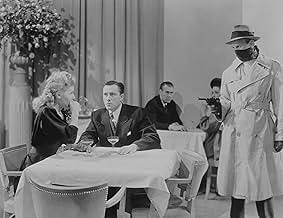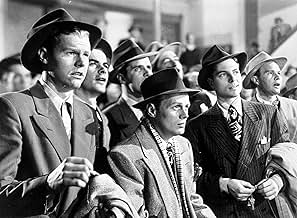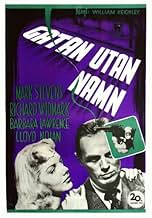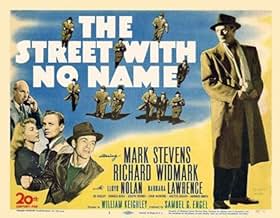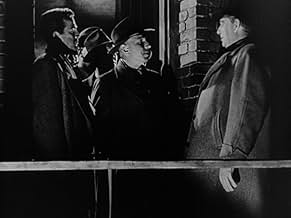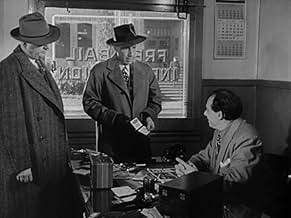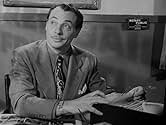Un agent secret du FBI infiltre une bande de gangsters sans pitié, mais sa vie est menacée par un mystérieux informateur qui transmet des informations privilégiées aux truands.Un agent secret du FBI infiltre une bande de gangsters sans pitié, mais sa vie est menacée par un mystérieux informateur qui transmet des informations privilégiées aux truands.Un agent secret du FBI infiltre une bande de gangsters sans pitié, mais sa vie est menacée par un mystérieux informateur qui transmet des informations privilégiées aux truands.
- Réalisation
- Scénario
- Casting principal
- Récompenses
- 2 victoires et 2 nominations au total
- Sparring Partner
- (non crédité)
- Bouncer at Gym
- (non crédité)
- Valentine Laval
- (non crédité)
- Cornerman
- (non crédité)
- Policeman at Arcade
- (non crédité)
- Man at Gym
- (non crédité)
- Prisoner
- (non crédité)
- Desk Sergeant
- (non crédité)
Avis à la une
Classy Noir with thrills, supenseful , tension, plot twists and shady characters . Including a semi-documentary style at times , in fact the film's opening prologue states: ''The motion picture you are about to see was adapted from the files of the Federal Bureau of Investigation. Wherever possible, it was photographed in the original locale and played by the actual F. B. I. Personnel involved¨. Stars Mark Stevens providing a good acting as the new FBI agent, along with Loyd Nolan as a tough chief who leads the investigations against the ominous criminal organization. But the best acting goes to the great Richard Widmark, giving an extraordinary show as a ruthless gangster with sadistic tendency by killing , hitting enemies and mistreating his girlfriend, the beautiful Barbara Lawrence. The Street with No Name(1948) is one of three consecutive Richard Widmark Noir films where he performed an evil gangster along with Kiss Of Death and Road House. They're well acccompanied by a remaining and effective support cast , such as : John McIntire, Ed Begley, Howard Smith, Donald Buka, Lane Chandler , Howard Smith , and Joseph Pevney , subsequently a notorious filmmaker .
It contains an atmospheric cinematography in black and white with plenty of lights and shades by Joseph MacDonald , who along with Nicolas Musuruca , John Alton and John Seitz are the best cameramen that worked in the Noir Film genre . The picture was competently directed by William Keighley. This filmmaker was expert on Noir as proved in Each dawn I die, Ladies they talk about, G Men, Bullets and ballots and The Street with no name . Rating : 7/10 . Better than average.
The film (whose title is allegorical) deals with F.B.I. rookie Mark Stevens infiltrating a criminal gang headed by Widmark; the Bureau gave Fox (who produced it) their full co-operation: the studio, in fact, had already made THE HOUSE ON 92ND STREET (1945) in a similar vein and, though THE STREET WITH NO NAME is marked by that earlier title’s innovative semi-documentary style, it actually ties in more with the gangster pictures of the 1930s. Incidentally, director Keighley had been responsible for a number of these over at Warners – including BULLETS OR BALLOTS (1936), which I may well check out presently on the strength of my positive response to this one!; Besides, the hero’s undercover activity and the suspense inherent in such a situation anticipates Raoul Walsh’s WHITE HEAT (1949) – while its scenario, also involving the concurrent presence of a ‘rat’ operating within the Bureau itself, would be replicated nearly 60 years later in Martin Scorsese’s THE DEPARTED (2006)!
At first glance, Stevens looks like an unlikely tough guy but, in retrospect, he acquits himself surprisingly well; Widmark – in his second film – has graduated from sadistic thug to unscrupulous gang boss (memorably introduced, with his face half-hidden behind a handkerchief during a night-club ‘job’, spitting a line at the orchestra conductor: “O.K., Stokowski…dry up!”). The film is also blessed with a terrific supporting cast (including Lloyd Nolan, John McIntire and Ed Begley – all of whom play F.B.I. operatives – Donald Buka being especially noteworthy among the criminals as Widmark’s taciturn but ruthless right-hand man, and only one prominent female figure in Barbara Lawrence as the typically-abused gangster’s moll).
As expected, Joe MacDonald’s shadowy lighting emerges to be an indispensable asset here – rendered even more effective (and realistic) by locations carefully-chosen to fit the desired mood of every sequence. A remarkable outburst of violence at the film’s climax (set inside a warehouse) is equivalent, then, to the icing on the cake.
Great to see Richard Widmark doing what he does best - playing villains, of course. Few actors could match Widmark when it came to that staple of screen heavies: losing their temper. This guy slaps people's faces with a karate-like precision that's remarkable. And just the way he tells some flunkie henchman he doesn't want around to "blow" is pure heaven. In a role like this, he owns the screen; he's like a well dressed rat always scavenging for his next meal.
I was reading a Cornell Woolrich story about a year ago and one of the characters used a Mark Stevens' picture as an alibi for where they had been at a certain time. Never having heard of Stevens I assumed it was just a made up movie star name and movie title ("I Wonder Who's Kissing Her Now".) Imagine my surprise when shortly thereafter I looked up his name and found out that there certainly was such an actor, a borderline leading man who apparently enjoyed some level of stardom during a 30 or so film career. Judging by his appearance here, he's a good, functional actor, though he has the sort of face it's easy to forget. Which is probably why he was selected for this part, as he isn't asked to carry the film (he's off screen for about half the running time) and as an undercover agent he's naturally required to blend in with his new environment. He does that quite well.
I expected this to be one of those dry docudramas that rose up in the late '40s and '50s. It did start that way, but then turned into an exciting and interesting story. The FBI becomes involved with bringing a gang of murdering thieves, led by Alec Stiles (Widmark), to justice. To do this, they send in a plant, Gene Cordell (Stevens).
Stiles sees someone he thinks might fit in with his gang and asks a mole in the police organization to check him out. In this way, he's able to get the FBI records. "Gene Cordell" becomes "George Manly" and is drafted into the Stiles group.
When a plan for a robbery is thwarted due to a tipoff, Stiles begins to think someone in his group is a snitch.
Good drama that holds attention.
Le saviez-vous
- AnecdotesThe chase inside the ferry terminal was filmed in the San Pedro Municipal Ferry Terminal in Los Angeles. The building now houses the Los Angeles Maritime Museum.
- GaffesThe wall behind Ed Begley during the Danker interrogation changes from brightly lit to sharply defined shadows of prison bars and back to brightly lit again.
- Citations
Alec Stiles: I haven't seen you around lately.
Gene Cordell: [as George Manly] I've been away.
Alec Stiles: Is that right?
Gene Cordell: Weekend in the country.
Alec Stiles: Courtesy of the city?
Gene Cordell: Something like that.
- ConnexionsFeatured in Los Angeles Plays Itself (2003)
- Bandes originalesBeg Your Pardon
(uncredited)
Written by Francis Craig and Beasley Smith
Performed by Marion Marshall during the opening stick-up
Meilleurs choix
- How long is The Street with No Name?Alimenté par Alexa
Détails
- Date de sortie
- Pays d’origine
- Sites officiels
- Langue
- Aussi connu sous le nom de
- The Street with No Name
- Lieux de tournage
- Municipal Ferry, San Pedro, Californie, États-Unis(As Center City: George Manly walks down street and is tailed to ferry.)
- Société de production
- Voir plus de crédits d'entreprise sur IMDbPro
- Durée1 heure 31 minutes
- Couleur
- Rapport de forme
- 1.33 : 1
Contribuer à cette page



